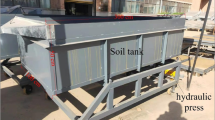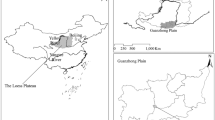Abstract
Purpose
To explore the impacts of wheat straw length and coverage on soil infiltration, runoff, and sediment production in sloping farmland under different mulching methods.
Materials and methods
In this study, an indoor simulated rainfall experiment (90 mm·h−1) was used to study the characteristics of runoff and sediment production in sloping farmland under different straw lengths (3 ~ 5, 8 ~ 10, and 13 ~ 15 cm), different mulching amounts (1.5, 2.5, 3.5, and 4.5 t·hm−2), and different mulching methods (surface mulching and mixed mulch).
Results and discussion
In the surface mulching, the average infiltration increased with increasing coverage and decreased with increasing length. In the mixed mulching, with the increase in coverage, the infiltration first increased and then decreased. When the coverage was less than or equal to 3.5 t⋅hm−2, with increasing length, the infiltration first increased and then decreased. However, when the coverage was 4.5 t⋅hm−2, with increasing length, the infiltration showed an increasing trend. The change trend of the average infiltration was opposite to the change trend of the cumulative runoff and sediment yield. When coverage and length were the same, the runoff cost of sediment control of the surface mulch was generally higher than that of the mixed mulch.
Conclusions
In this experiment, when the length was 3–5 cm and the amount was 4.5 t⋅hm−2, the runoff was the lowest, and the infiltration was the highest under the surface mulch. The sediment production was the lowest when the length was 8–10 cm and the coverage was 3.5 t⋅hm−2 under the mixed mulch. Straw mulching can reduce soil loess, which has certain significance for soil erosion control and the healthy and sustainable development of agriculture.






Similar content being viewed by others
References
Benaud P, Anderson K, Evans M, Farrow L, Glendell M, James MR, Quine TA, Quinton JN, Rawlins N, Rickson JR, Brazier RE (2020) National-scale geodata describe widespread accelerated soil erosion. Geoderma 371:114378. https://doi.org/10.1016/j.geoderma.2020.114378
Cao WH (2003) Advocate developing soil and water conservation with water-saving in the Loess Plateau. Soil Water Conserv China (01):41–44. https://doi.org/10.16843/j.sswc.2003.01.012
Chai CG (2011) Experiment about over-Reinforced Problem of Concrete Structure Node 40(S1):54–55
Chamizo S, Cantón Y, Lázaro R, Solé-Benet A, Domingo F (2012) Crust composition and disturbance drive infiltration through biological soil crusts in semiarid ecosystems. Ecosystems 15:148–161. https://doi.org/10.1007/s10021-011-9499-6
Fang HY, Sun LY (2017) Modelling soil erosion and its response to the soil conservation measures in the black soil catchment, Northeastern China. Soil Tillage Res 165:23–33. https://doi.org/10.1016/j.still.2016.07.015
Fang F, Wang F, Shi ZL, Zheng XQ, Shao YH, Li X, Qiu L (2017) Quantitative estimation on straw nutrient resources and emission of pollutants from straw burning in Beijing-Tianjin-Hebei region. Trans Chin Soc of Agri Eng 33(03):1–6. https://doi.org/10.11975/j.issn.1002-6819.2017.03.001
Gabriel JL, García-González I, Quemada M, Martin-Lammerding D, Madrid S (2021) Cover crops reduce soil resistance to penetration by preserving soil surface water content. Geoderma 386:114911. https://doi.org/10.1016/j.geoderma.2020.114911
Guo J, Wen AB, Yan DC, Shi ZL (2014) Quantifying catchment scale sediment source using composite fingerprinting technique. Trans Chin Soc of Agri Eng 30(2):94–104. https://doi.org/10.3969/j.issn.1002-6819.2014.02.013
Huo L, Pang HC, Zhao YG, Wang J, Lu C, Li YY (2017) Buried straw layer plus plastic mulching improves soil organic carbon fractions in an arid saline soil from Northwest China. Soil Tillage Res 165:286–293. https://doi.org/10.1016/j.still.2016.09.006
Jin QF, Ma XQ, Wang WH, Yang SY, Guo FT (2017) Temporal and spatial variations of PM2.5 emissions from crop straw burning in eastern China during 2000–2014. Acta Sci Circumst 37(02):460–468. https://doi.org/10.13671/j.hjkxxb.2016.0294
Keesstra S, Pereira P, Novara A, Brevik EC, Azorin-Molina C, Parras-Alcantara L, Jordan A, Cerda A (2016) Effects of soil management techniques on soil water erosion in apricot orchards. Sci Total Environ 551–552:357–366. https://doi.org/10.1016/j.scitotenv.2016.01.182
Khan MN, Gong Y, Hu T, Lal R, Zheng J (2016) Effect of slope, rainfall intensity and mulch on erosion and infiltration under simulated rain on purple soil of South-Western Sichuan Province, China. Water 8:528–536. https://doi.org/10.3390/w8110528
Kim YJ, Choo BK, Cho JY (2017) Effect of gypsum and rice straw compost application on improvements of soil quality during desalination of reclaimed coastal tideland soils: ten years of long-term experiments. CATENA 156:131–138. https://doi.org/10.1016/j.catena.2017.04.008
Li CD, Li ZB, Ma JY, Ma B (2017) Hydraulic characteristic of overland flow on loess farmland slope under mulch with different wheat straw lengths. Trans Chin Soc of Agri Eng 33:153–160. https://doi.org/10.11975/j.issn.1002-6819.2017.04.022
Liu HQ, Yang JH, Diao YF, Lei TW, Rahma AE (2021) The hydrodynamic mechanism of rainfall runoff from loess slope incorporated with straw. Land Degrad Dev 32(14):3812–3822. https://doi.org/10.1002/ldr.3941
Liu HQ, Yang JH, Liu CX, Diao YF, Ma DP, Li FH, Rahma AE, Lei TW (2020) Flow velocity on cultivated soil slope with wheat straw incorporation. J Hydrol 584:124667. https://doi.org/10.1016/j.jhydrol.2020.124667
Liu H, Zhou HF, Liu X (2015) Analysis of soil moisture migration on sand dune under the condition of heavy rainfall. J Soil Water Conserv 29(2):157–162,182. https://doi.org/10.13870/j.cnki.stbcxb.2015.02.029
Lucas-Borja ME, Javier GR, Plaza-Lvarez PA, Sagra J, Ibaez JDLH (2018) The impact of straw mulching and salvage logging on post-fire runoff and soil erosion generation under Mediterranean climate conditions. Sci Total Environ 654:441–451. https://doi.org/10.1016/j.scitotenv.2018.11.161
Omidvar E, Hajizadeh Z, Ghasemieh H (2019) Sediment production, runoff and hydraulic characteristics in straw and rock fragment covers. Soil and Tillage Res 194:104324. https://doi.org/10.1016/j.still.2019.104324
Pan DL, Yang SW, Song YQ, Gao XD, Wu PT, Zhao XN (2019) The tradeoff between soil erosion protection and water consumption in revegetation: evaluation of new indicators and influencing factors. Geoderma 347:32–39. https://doi.org/10.1016/j.geoderma.2019.02.003
Parhizkar M, Shabanpour M, Lucas-Borja ME, Zema DA, Li S, Tanaka N, Cerdà A (2020) Effects of length and application rate of rice straw mulch on surface runoff and soil loss under laboratory simulated rainfall. Int J Sediment Res 36(4):468–478. https://doi.org/10.1016/j.ijsrc.2020.12.002
Prosdocimi M, Jordan A, Tarolli P, Keesstra S, Novara A, Cerda A (2016) The immediate effectiveness of barley straw mulch in reducing soil erodibility and surface runoff generation in Mediterranean vineyards. Sci Total Environ 547:323–330. https://doi.org/10.1016/j.scitotenv.2015.12.076
Reynolds ERC (2010) The percolation of rainwater through soil demonstrated by fluorescent dyes. Eur J Soil Sci 17(1):127–132. https://doi.org/10.1111/j.1365-2389.1966.tb01459.x
Sahu JB, Prasad M, Sahu R, Kumar D (2019) Crop residue management under changing climate scenario. Curr J Appl Sci Techno PP, 1–6. https://doi.org/10.9734/cjast/2019/v37i630313
Satoru M, Shin U, Shuichiro Y, Yamada K (2015) Floor cover percentage determines splash erosion in forests. Soil Sci Soc Am J 79:1782–1791. https://doi.org/10.2136/sssaj2015.05.0171
Shi ZH, Yue BJ, Wang L, Fang NF, Wang D, Wu FZ (2013) Effects of mulch cover rate on interrill erosion processes and the size selectivity of eroded sediment on steep slopes. Soil Sci Soc Am J 77:257–267. https://doi.org/10.2136/sssaj2012.0273
Sosa-Perez, MacDonald LH (2017) Effects of closed roads, traffic, and road decommissioning on infiltration and sediment production: a comparative study using rainfall simulations. Catena 159:93-105. https://doi.org/10.1016/j.catena.2017.08.004
Tang T, Hao MD, Feng X (2008) Effects of straw mulch application on water loss and soil erosion under simulated rainfall. Research of Soil and Water Conservation 15:13–15+44
Vega JA, Fernández C, Fonturbel T, González-Prieto S, Jiménez M (2014) Testing the effects of straw mulching and herb seeding on soil erosion after fire in a gorse shrubland. Geoderma 223–225:79–87. https://doi.org/10.1016/j.geoderma.2014.01.014
Wang F, Li R, Mu XM, Yang XM (2004) Characteristics and regional differences of runoff cost of sediment control of conservation measures and their simulation in Weihe River Basin. Soil Water Conserv China 02:12–17. https://doi.org/10.3969/j.issn.1672-3007.2004.02.003
Wang L, Ma B, Wu F (2017a) Effects of wheat stubble on runoff, infiltration, and erosion of farmland on the Loess Plateau, China, subjected to simulated rainfall. Solid Earth 8(2):1–28. https://doi.org/10.5194/se-8-281-2017
Wang LH, Dalabay N, Lu P, Wu FQ (2017) Effects of tillage practices and slope on runoff and erosion of soil from the Loess Plateau, China, subjected to simulated rainfall. Soil and Tillage Res 166:147–156. https://doi.org/10.1016/j.still.2016.09.007
Wang Y, Fan J, Cao L, Liang Y (2016) Infiltration and runoff generation under various cropping patterns in the red soil region of china. Land Degrad Dev 27:83–91. https://doi.org/10.1002/ldr.2460
Whelan MJ, Anderson JM (1996) Modelling spatial patterns of throughfall and interception loss in a Norway spruce (Picea abies) plantation at the plot scale. J Hydrol 186:335–354. https://doi.org/10.1016/S0022-1694(96)03020-X
Wu JQ, Zhang JF, Gao R (2009) Physical simulation experiments of effects of macropores on soil water infiltration characteristics. Transactions of the CSAE 25(10):13–15. https://doi.org/10.3969/j.issn.1002-6819.2009.10.003
Xu XM, Zheng FL, Tan C, Wu HY (2015) Erosion control effects of cornstalk mulching on loess hillslope with gully. Transactions of the Chinese Society for Agricultural 46(08):130–137. https://doi.org/10.11975/j.issn.1002-6819.2017.03.001
Yang L, Feng QY, Chen LD (2020) Ecosystem services of soil and water conservation measures on the Loess Plateau. Resources Science 42(01):87–95
Zeng C, Wu GL, Huang Z, Liu Y (2019) Fine roots determine soil infiltration potential than soil water content in semi-arid grassland soils. J Hydrol 578:124023. https://doi.org/10.1016/j.jhydrol.2019.124023
Zeng JH, Li ZB, Ma B, Wang SS, Zhang ZY, Wang YX (2020) Effects of wheat straw length and coverage on runoff and sediment production. J Soil Water Conserv 34:98–103+111. https://doi.org/10.13870/j.cnki.stbcxb.2020.04.015
Zhang B, Benmokrane B (2005) Large model test of prestressed carbon fibre reinforced polymer ground anchors. Can J Civil Eng 32(6):1064–1074. https://doi.org/10.1139/l05-058
Zhang DH, Shi HF, Zhu JH, Su MN, Jin WL (2017) Cover separation of CFRP strengthened beam-type cantilevers with steel bolt anchorage. Eng Struct 156:224–234. https://doi.org/10.1016/j.engstruct.2017.10.056
Zhang KL, Hosoyamada K (1998) Splash erosion process and its relation to slope gradient. Sci Geogr Sin 6:561–566. https://doi.org/10.1088/0256-307X/16/9/027
Zhang YF, Wang QJ, Hu H, Chen WZ, Wang XL, Rasaily RG (2016) Effect of maize straw mulching on water and soil conservation in sandy soil and loam soil of North China. Transactions of the Chinese Society for Agricultural Machinery 47:138–145+154. https://doi.org/10.6041/j.issn.1000-1298.2016.05.019
Zhang Z, Luo J, Chen B (2019) Spatially explicit quantification of total soil erosion by RTK GPS in wind and water eroded croplands. Sci Total Environ 702:134716. https://doi.org/10.1016/j.scitotenv.2019.134716
Zhao G, Mu X, Jiao J, An Z, Klik A, Wang F, Jiao F, Yue X, Gao P, Sun W (2017) Evidence and causes of spatiotemporal changes in runoff and sediment production on the Chinese Loess Plateau. Land Degrad Dev 28(2):579–590. https://doi.org/10.1002/ldr.2534
Zhao GJ, Mu XM, Strehmel A, Tian P (2014) Temporal variation of streamflow, sediment load and their relationship in the Yellow River basin. China Plos One 9(3):e91048. https://doi.org/10.1371/journal.pone.0091048
Zhao MD, Tang GA, Chen Z, Zhu HC (2002) Slope classification systems and their slope spectrum in hill and gully area of the Loess Plateau. Bull Soil water Conserv 4:33–36. https://doi.org/10.13961/j.cnki.stbctb.2002.04.009
Acknowledgements
We would like to thank the reviewers and the editor for their constructive comments and suggestions. This research was supported by grants from the National Natural Science Foundation of China (grants 41771311 and 41561144011).
Author information
Authors and Affiliations
Corresponding author
Ethics declarations
Conflict of interest
The authors declare no competing interests.
Additional information
Responsible editor: Lu Zhang
Publisher's Note
Springer Nature remains neutral with regard to jurisdictional claims in published maps and institutional affiliations.
Rights and permissions
Springer Nature or its licensor holds exclusive rights to this article under a publishing agreement with the author(s) or other rightsholder(s); author self-archiving of the accepted manuscript version of this article is solely governed by the terms of such publishing agreement and applicable law.
About this article
Cite this article
Wang, C., Ma, B., Wang, Y. et al. Effects of wheat straw length and coverage under different mulching methods on soil erosion on sloping farmland on the Loess Plateau. J Soils Sediments 23, 923–935 (2023). https://doi.org/10.1007/s11368-022-03342-5
Received:
Accepted:
Published:
Issue Date:
DOI: https://doi.org/10.1007/s11368-022-03342-5




